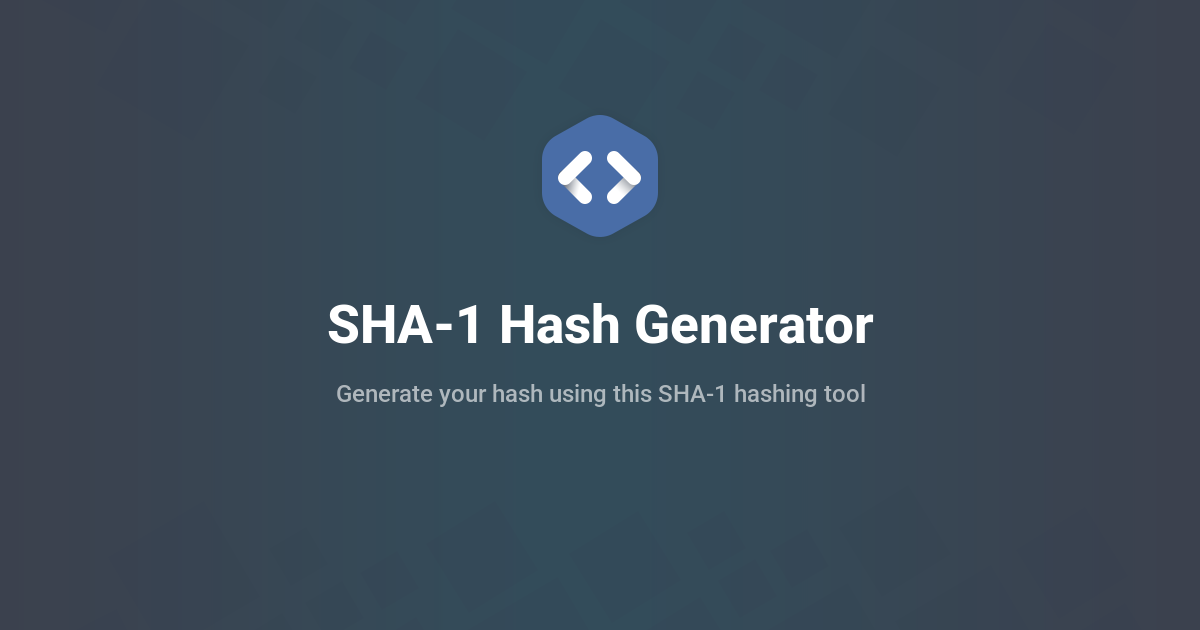
SHA-1 generator
Created on 24 September, 2025 • Generator tools • 100 views • 3 minutes read
Generate SHA-1 hashes online for text or files. Learn SHA-1 uses, limitations, and secure alternatives.
SHA-1 Generator – Everything You Need to Know in 2025
Introduction
When it comes to hashing algorithms, SHA-1 (Secure Hash Algorithm 1) has played a huge role in the history of cryptography. Although it has been deprecated for many security purposes, it is still used in some systems for checksums and legacy compatibility. A SHA-1 generator is a tool that creates SHA-1 hashes for text, passwords, or files.
In this article, we’ll explore what SHA-1 is, how a SHA-1 generator works, its benefits, weaknesses, and whether you should still use it in 2025.
What is SHA-1?
SHA-1 stands for Secure Hash Algorithm 1, designed by the U.S. National Security Agency (NSA) and published by NIST in 1995.
- Output Size: 160 bits (40 hexadecimal characters)
- Design Purpose: Digital signatures, data integrity, password hashing (in older systems)
- Status: Deprecated by NIST and considered cryptographically broken since 2017 due to collision attacks.
What is a SHA-1 Generator?
A SHA-1 generator is an online or software-based tool that applies the SHA-1 algorithm to an input. No matter how long the input is, the output is always a 40-character hash.
Example:
- Input: hello
- SHA-1 Hash: aaf4c61ddcc5e8a2dabede0f3b482cd9aea9434d
This makes SHA-1 useful for quick data fingerprinting and file verification, though not for secure encryption.
How Does a SHA-1 Generator Work?
Step 1: Input
You provide text, a password, or a file into the SHA-1 generator.
Step 2: Algorithm Processing
SHA-1 processes data in 512-bit blocks using a series of logical functions, bitwise operations, and modular arithmetic.
Step 3: Output
The final output is always a 160-bit hash represented as a 40-character hexadecimal string.
Why Use a SHA-1 Generator?
Even though SHA-1 is not secure for modern cryptography, it still has some practical applications:
1. File Integrity Verification
Developers sometimes provide SHA-1 checksums with their software downloads. A user can generate the SHA-1 hash of their file and compare it to ensure the file wasn’t corrupted.
2. Legacy Systems
Older applications and systems still rely on SHA-1 for compatibility. A generator helps bridge this gap when working with such systems.
3. Quick Data Fingerprinting
Because SHA-1 produces short, fixed-length hashes, it is sometimes used to index or identify files in non-security applications.
Limitations of SHA-1
While SHA-1 generators are useful, there are serious limitations:
- Collision Attacks: In 2017, Google demonstrated the first practical SHA-1 collision attack (called “SHAttered”).
- Deprecated for Security: Organizations like NIST and major browsers (Chrome, Firefox, Edge) stopped trusting SHA-1 in SSL/TLS certificates.
- Weak for Password Hashing: Hackers can use rainbow tables and brute-force attacks to crack SHA-1 hashes easily.
SHA-1 vs Other Hash Algorithms
AlgorithmOutput LengthSecurity LevelCommon UsesMD5128-bit (32 hex)Very WeakChecksums, legacy softwareSHA-1160-bit (40 hex)WeakLegacy apps, file verificationSHA-256256-bit (64 hex)StrongCryptography, blockchain, SSLSHA-3Variable (224–512-bit)Very StrongModern cryptographyBcryptVariableVery StrongPassword hashing
Practical Example of Using a SHA-1 Generator
Imagine you are downloading an open-source software package:
- The developer provides a SHA-1 checksum for the file.
- You generate the SHA-1 hash of the downloaded file.
- If the hashes match, the file is intact.
- If they differ, the file may have been corrupted or tampered with.
Online SHA-1 Generators
Online tools allow you to:
- Generate SHA-1 hashes from text
- Hash files for integrity checks
- Compare SHA-1 hashes for verification
⚠️ Important Note: Do not use online generators for sensitive passwords or confidential data, since you can’t guarantee how the input is stored.
Should You Still Use SHA-1 in 2025?
The short answer: No, not for security purposes.
- For password hashing → Use bcrypt, Argon2, or PBKDF2.
- For digital signatures or SSL certificates → Use SHA-256 or SHA-3.
- For file verification or legacy applications → SHA-1 may still be acceptable.
If you need strong cryptography, SHA-1 should never be your first choice.
Conclusion
A SHA-1 generator is a tool that converts input data into a 40-character hash using the SHA-1 algorithm. While it was revolutionary in the 1990s, SHA-1 is no longer secure enough for modern cryptographic needs.
That said, SHA-1 is still valuable for file verification, legacy applications, and quick hashing where ultimate security is not required.
If you’re building modern systems, always use stronger algorithms like SHA-256, SHA-3, or bcrypt.
Popular posts
-
Random number generatorGenerator tools • 133 views
-
Emojis removerText tools • 129 views
-
Lorem Ipsum generatorGenerator tools • 129 views
-
Reverse lettersText tools • 121 views
-
Old English text generatorText tools • 121 views